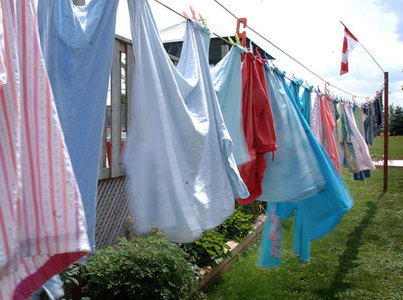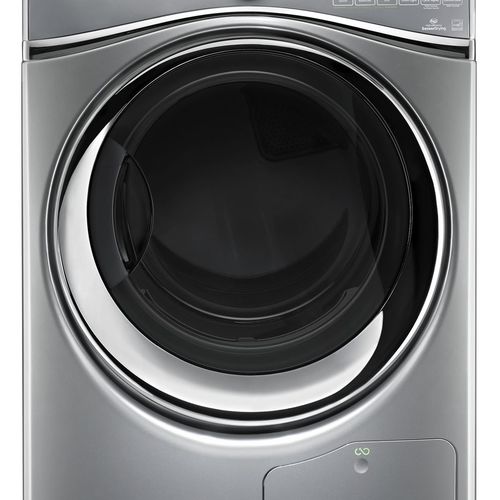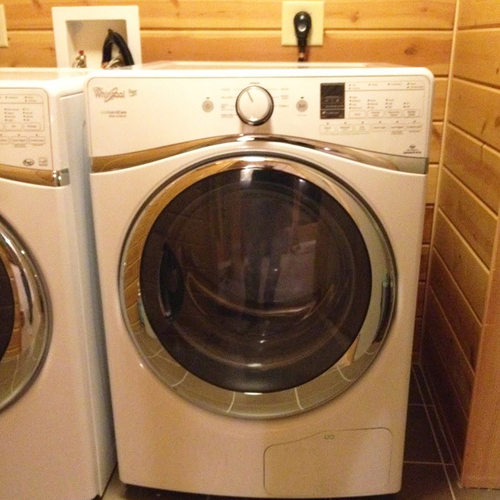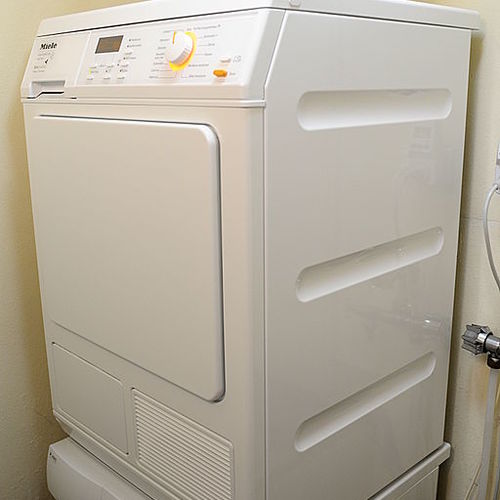
Image Credit: insteadofthedishes.wordpress.com
Last week, we took a look at how to save energy and water with clothes washing. This week we’ll turn our attention to drying, which accounts for approximately 6% of all household electricity consumption in the U.S.
The two are closely related. The more effectively we extract water from clothes during the spin cycle of washing, the less energy it takes to dry them. That’s another reason the new horizontal-axis (H-axis or front-loading) clothes washers are so good. The extremely fast spin speeds remove far more moisture than vertical-axis top-loaders—and more than some H-axis machines.
When we traded in our older, entry-level Frigidaire H-axis on a new Whirlpool Duet mode, the difference in water removal was dramatic. It seemed that the clothes came out of the washer only damp, cutting the drying time nearly in half. Moisture is removed so effectively because our new washer has a maximum spin speed of 1,100 revolutions per minute (rpm) vs.–I think–700 rpm for our old Frigidaire. (Newer and higher-end Frigidaire washers have significantly faster spin speeds.)
The German company Miele sells washers in the U.S. with spin speeds up to 1,600 rpm, and I’ve read online testimonials claiming drying times of 15-20 minutes when using these models. And I just learned that the Slovenian company Gorenje makes clothes washers with spin speeds up to 2,000 rpm, though these products are not sold in the U.S. (yet).
If you’re in the market for a new dryer, look for a model that senses remaining moisture so that the dryer doesn’t keep operating once clothes are dry. Also, a dryer with a “cool-down” cycle will shut off the heating element when the clothes are nearly dry, allowing the residual heat to complete the job.
Then install, operate, and maintain the dryer properly. Make sure that the venting line is as short and straight as possible to avoid restricting airflow. To save energy during operation, keep the lint filter clean, avoid overloading, and wash similar clothes together (because some fabrics dry more quickly than others). If you take out clothes before they are 100% dry and hang them up, you’ll save a bit on drying and reduce the need for ironing—another energy use associated with laundry.
For the most energy-efficient clothes drying, the solution is to use a clothesline instead of a dryer. There are a number of reasons people don’t hang laundry outdoors: too little time, inclement weather, preference for softer clothes that have been tumble-dried, soiling from pollution (including outdoor wood boilers) or sap dripping from trees, prohibitions against hanging laundry outdoors in some places, and simple laziness. Some of these certainly apply to me—mostly in the inclement weather and laziness areas!
Years ago I gained a lot of experience with clothesline drying. It surprises many people to learn that clothes will dry outdoors even in very cold weather. The clothes freeze, but then the frozen water evaporates through the process of “sublimation” (direct conversion of solid to gas, without first going through a liquid phase).
Hanging laundry on a clothesline increases the life of your clothes. Every time you empty the lint filter in a dryer, that lint you’re taking out represents a shortened life of the clothes that were just dried.
Hanging laundry indoors can help humidify the indoor air. Leaky houses in cold climates get very dry in the winter because the outdoor air leaking in hold very little moisture. Evaporating moisture from clothes introduces humidity without also putting fine mineral particles into the air (as happens with low-cost humidifiers). Note that I do not recommend venting an automatic dryer into a home.
Don’t even think about venting a gas dryer indoors, because doing so would introduce combustion gases. But even an electric dryer should not be vented indoors, because the airborne fibers from the clothes can cause respiratory irritation.
Unfortunately, drying clothes outdoors is illegal in many places. According to an article last month in the New York Times, about 60 million people in the U.S. live in private communities, and a majority of these prohibit outdoor clothes drying. At least four states (Vermont, Maine, Colorado, and Hawaii) have overridden those prohibitions in the past year with laws that protect residents’ rights to hang clothes outdoors. Florida and Utah already had such laws, and similar measures are being considered in Maryland, Virginia, North Carolina, and Oregon. The “right to dry” movement is clearly growing nationally.
I invite you to share your comments on this blog. You can also follow my musings on Twitter.
Weekly Newsletter
Get building science and energy efficiency advice, plus special offers, in your inbox.















17 Comments
Condensing Dryers
In a tight, well insulated home, condensing dryers are the way to go if you insist on heated drying. They use "just a smidge" more electricity than standard vented dryers, but since there's no vent, they eliminate the energy penalty for the unconditioned air that's brought in to balance exhaust out through the dryer duct. On the smaller side, get rid of the vent and you are also eliminating a 4" hole in your wall insulation. If you stack the dryer on top of a washer, you won't even need a separate drain!
Here's a link to one from Bosch at about $1,000: http://www.bosch-home.com/us/products/laundry/dryers/compact/WTE86300US.html. I think Asko and Miele also sell these in the U.S.
Condensing dryers
John
I've been watching these things for a few years since I saw the LG version at the IBS in Orlando a few years ago but I'm reluctant to dive in due to early problems with really long cycle times and concerns about being an early adopter. (I still have one of the early horizontal axis washers that holds moldy water in the gasket and stinks to high heaven if we don't use bleach to wash our clothes)
I like the idea of using Bosch since they are made near me in North Carolina. Do you have personal experience with this product? Hows the cycle time? Are you happy with it?
At best, only good in heating-dominated climate
John's point is pretty sensible. But, I know of two quick caveats already.
We put in two Asko condensing dryers nearly ten years ago. When they run, they noticeably warm up the room they're in, and hardly any condensate accumulates in the little removable container you're supposed to dump after every few loads. It seems clear that for these models, most of the moisture is put out into the room around the dryer.
During our air-conditioning season, this caused many a complaint. By the time you ran a couple of loads, the laundry area was very hot & humid.
In a normal (not superinsulated) house in the heating season, the extra heat and humidity would be welcome, but not most of the year in many climates.
Hopefully there are units out there that work better now, but I'd be cautious with these in any house that has a cooling season or is well-sealed.
Hanging Laundry Works
Great article, I enjoyed your overview of how which washer/dryer designs work best. At home, I use a small drying rack that fits a moderate size load of laundry - I live in an apartment with no patio or yard, so it's been very effective at drying clothes without worrying about the weather outside (which isn't that bad here in the SF Bay Area).
Michael,
I don't have
Michael,
I don't have personal experience with condensing dryers, though millions of people in Europe and Asia do. I would think that any major bugs in the Bosch (and other) systems would be worked out by now...they've been making them for other markets for 10+ years. I spoke with a client recently who has had a Bosch unit for the past 3-4 years, and he's very happy with it....reasonable cycle times, no maintenance issues.
Regarding Doug's comment on condensate, all the newer models that I know of have a condensate drain (no holding tank). In a stacked laundry situation, you should be able to drain the condensate via the same drain that the washing machine uses.
Love Line Drying!!
I live in the Blue Ridge Mountains in central Virginia, and we installed a folding clothesline 1-1/2 years ago. We use it most of the year and have noticed a significant drop (about 15 - 20%) in our electricity usage as a result. We now are line drying on racks indoors during cold and rainy periods. Our clothes now have a wonderful fresh smell and our electric bill has not exceeded $100/month since we put in the clothesline (we actually got our bill down to $65 in September!).
There was a bill in our State Legislature earlier this year that would have force HOAs to allow the installation of clotheslines statewide (with certain aesthetic requirements still allowed), but unfortunately it failed. Maybe this year they will try again?!
clothes centrifuge
Another option is a clothes centrifuge which spin up to 3200 rpm, have extra advantage that they dont bake in the remeining soap and dirt residues during they drying process so clothes are actually a bit cleaner
Condensing Dryers
Considering cost and concern for air quality and energy in my home I decided to conduct an experiment using an electric dryer and a 40-pint dehumidifier to dry my clothes.
First of all--Get a front loading washing machine. Despite some complaints there are many great models that all starting to show up on the resale market ($150-500) and they do cut drying time nearly in half--ours 55%.
Second--I live in Seattle where it is possible to line dry about 4 months a year during the cooling season so there are not any issues with extra heat produced by the dryer. I tried line drying after much protest and was a convert after a few loads. Line dry during the cooling season and you will be disappointed when you have to start using your drying again.
Finally--I found that creating a closed loop between the dehumidifier and the dryer using simple metal ductwork and foil tape, I was able to dry my clothes using about 60% of the energy of a normal dryer cycle. It would be much more energy savings but the motor in the dryer uses around 1700 watts to turn the drum and blow the air around. That really doesn't matter anymore because the beauty of a closed loop system is that the extra energy provides a significant amount of space heating in the small tight house where I live.
I have been disappointed that the dryer industry has not developed better closed loop condensing dryers that actually work well at condensing moisture out of clothes to dry them. There currently are no Energy Star rated clothes dryers and this seems like the logical step.
Line Drying Advocate
Living in Hawaii, I am able to line dry year round. My only challenge comes when we have rain for a few days. For those occasions, I have lines under the porch that I use (I also hang sun sensitive colored clothes there).
I hate to say it, but there are few like me down here. With one of the nation's highest electricity rates, you'd think that would not be the case. Unfortunately, it is.
Dryer on heating pump basis
We actually bought a new dryer that is an condensing dryer based on a heating pump system. This you can get from Siemens and it needs less than a quarter of energy a regular condensing dryer needs. A good and sustainable investment i think. (For drying 7kg clothes it needs abt. 1.4kWh)
Love my clothesline!
I have a very sturdy (I think it's from England) umbrella clothes line. We are in Montana and we hang clothes most of the year (except during snow and rain storms). Although, I LOVE it when our sheets get a extra rain rinse. We use cloth diapers too, those I sometimes need to use the dryer just because I'm out of diapers (so poor planning on my part!). I'll also stick a clean dry towel in with the diapers and it noticeably reducing the dry time. I understand that Vermont and Colorado have passed "Right to dry" laws, which prohibit HOA from banning clotheslines. I think that's a good start and hope other states follow that path.
Heat pump condensing dryers
Cajus,
I didn't realize the heat pump dryers were on the market....I was only aware of them in concept form. Judging from your reference to "7kg" and "1.4kWh", I take it you're not in the U.S.? 1.4kWh for a 7kg load is at least 50% less than a standard dryer! That's fabulous. Where did you purchase/install yours?
Air drying.
I've been using a drying rack in my studio apartment here in Seattle for a couple of months now. It is definitely saving me money not having to use the coin-op laundry in the basement. I am also a big fan of the environmental benefits. I've been skeptical of laundry racks in the past as I don't have much floor space to spare, but I found a really cool one that is made locally here that attaches to a window. It keeps the laundry out of the way, and I don't have to mount anything permanently. Their website is http://www.windowdry.com.
Heat pump condensing dryer
Hi John,
i am from Germany, and the product is on the market for nearly a year now. You are right, it is nealy 50% off the power a "normal" pruct needs, that was our reason to give that much money (abt. €1.200).
Greeting from Hamburg, Northern Gernamy
Cajus Pruin
Air drying and dehumdifier
I live in the Uk where inclement weather is our biggest reason for not hanging clothes outside.
I air dry clothes in a cupboard with my boiler during the winter as the residual heat dries things quickly.
My problem is in summer when it rains. Then things take forever indoors and I can't put them outside. I now have the solution - a small dehumidifier unit. I only need to run it a bit to make all the difference to the drying.
Shallow-depth, Stackable and High-Efficiency?
I'm planning on converting a 24 inch deep pantry closet off the kitchen to a laundry center, looking forward to the day when I can't negotiate the stairs to the basement.
Can anyone recommend a good washer/dryer that can stack in such a shallow space?
On a related question, has anyone installed a filter on the washer drain to keep all of that lint out of their septic field?
Thanks!
On air drying with a dehumidifier
Philippa,
Your solution seems like an inefficient one to me. You're basically spending electricity to transfer some of the water from your clothes to the dehumidifier reservoir instead of drying the closes with a clothes dryer and sending that moisture outside through the dryer vent. If this is a solution being used only occasionally, that's probably fine. If it's something you plan to do for half the year, I think you should reconsider buying a small dryer.
Skidmark: As for a small washer-dryer set, I'd look at Meile and Asko. It seems to me that I've seen some quite small units designed for European space-efficiency.
Log in or create an account to post a comment.
Sign up Log in